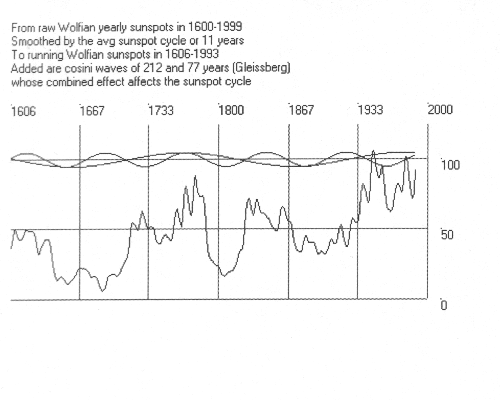

The following relations do not themselves prove anything but that the sunspot cycles may constitute a complicate web, whose values are deductible from each other.
We have five basic cycles:
1. 9.94 years (artifact analysis, high maxima) 2. 10.28 years (the most popular length) 3. 10.54 years (autocorr. analysis, if we omit the unreliable 1760's) 4. 11.07 years (the supposed mean cycle) 5. 11.86 years (one Jovian year)
Now we get the following relations:
1. (1 - 1:15) Jovyrs = 11.071
2. (1 - 1:7.5) Jovyrs = 10.280
3. (1 - 1:9) Jovyrs = 10.544
4. (1 - 1:6 1/6) Jovyrs = 9.937
5. (1-29/30) * 10.280 = 9.937
6. 11.862 - 11.071 = 11.071 - 10.280
= 0.79 years
7. 10.544 - 9.937 = 0.61 years (the orbital period of Venus)
As a schema:
11.071
-2/15 xx +2/15
xx_________xx________xx
10.280 11.862
xx -1/15
xx
-1/6.16 xx -1/9
xx_________xx_________xx
9.937 10.544
The following multiples give us the short supercycles:
4*11.071 = 44.284 yrs 5*10.280 = 51.400 yrs 6*10.544 = 63.264 yrs 7*10.280 = 71.960 yrs (Gleissberg minimum) 7*11.071 = 77.497 yrs (Gleissberg average) 7*11.862 = 83.034 yrs (Gleissberg maximum) 7.5*11.071 = 83.033 yrs 7.5*11.862 = 88.965 yrs
Some relations:
63.264-51.400=11.864 = one Jovian year 83.034-71.960=11.074 = Gleissberg cycle limits = one mean cycle 162.11-150.25=11.86 = double Gleissberg limits = one Jovian year 2*(88.965-63.264)=51.402 19*11.071 - 16*11.862 = 2*10.28 12*10.280 - 4*11.071 = 6.666.. Jovian years 3*63.264=189.79 years = 16 Jovian years 2*83.034=166.07 years = 14 Jovian years = 15 mean sunspot cycles
The Elatina main cycle:
4*77.497 = 7*44.284 = 309.99 years (Earthly influence?) 310/44.284 = 7.000 (echo of Gleissberg upper?) 310/51.400 = 6.031 (echo of Gleissberg lower?)
Now we are on the borderline of our ability to verify our theoretical calculations with empirical results. Despite of this risk I made some calculations that try to combine both. Only we must remember the experimental character of them.
First a search for the 1000+-year cycles as multiples of the medium cycles:
28*44.284 = 1233.6 years = 104 Jovian years 24*51.400 = 1233.6 years = 104 Jovian years 16*71.960 = 1151.4 years = 104 mean cycles 16*83.034 = 1328.5 years = 112 Jovian years = 120 mean cycles
Next a search for the 2000+-year cycles:
44.28 * 51.40 = 2276 years - (relation between 44.28 and 51.40 is the famous 46:54) 14*15 = 210 cycles = 2324.9 years 14*14 = 196 Jovian years = 2324.9 years Neftel-Suess hypercycle = 2289.4 years = 193 Jovian years
And back to the 1000+ years:
2289.4-1233.6 = 1055.8 years = 89 Jovian years 1233.6-1055.8 = 177.8 years = 15 Jovian years 954.89 years = 80.5 Jovian years 2*(1055.8-954.9) = 201.8 (200-year cycle mean?)
And:
16 Jovian years / 26 Jovian years (Elatina figure) = 0.615 = the orbital period of Venus
Table of how the 955 year (80.5 Jovyr) supercycle dispenses with the relation of 0.464 to 0.536:
954.9
443.1 511.8
205.6 274.3
95.3 110.2 147.0
44.2 51.2 78.8
20.5 23.7 27.4 42.2
9.5 11.0 12.7 22.6
(22.6-12.7 = 9.9)
Some of these values are more apparent than others, because some partially cancel each other.
If we take the minima of the 46 sunspot cycles from 1501 to 1996 we can see indications of both a 15-cycle and an 18-cycle (14 and 17 Jovian years) supercycle depending on whether minimum is near or away of the Jovian perihelion. If this alternation is representative, the minimum common denominator gives a supercycle of 90 cycles or 84 Jovian years. 90*11.071 = 84*11.862 = 996.4 years. If we add one Jovian year we get 1008.3 years (5*201.65 years).
200-210 and 1000-1050 years seem to be the greatest known oscillation periods in Sun's intensity. They also seem to affect the temperature on Earth. During the last 400 years there seems to be a great resemblance between Wolfian numbers 221 years apart (the upper limit of the 200-year cycle?). The years 1606-1779, smoothed with 12 years, have roughly the same kind of variability as the years 1827-2000. Only the intensity is about 20-30 Wolfs higher continuously throughout these periods. The Maunder minimum repeats itself in the minimum of 1870-1930. The effect is not so dramatical, however, because of the higher Wolfian number. Smoothed with the Gleissberg cycle, the Wolfian number has a very steady value around 45 Wolfs from 1710 to 1930 or lasting a time of about 220 years. During the Maunder minimum the smoothed value was about 15 and now is approaching a value of 70 Wolfs.
If we assume that the temperature records correlate with sunspot intensity, we can in rough terms assume that the 180-year cycle dominated from about 1100 to 1450 and the 220-year cycle dominates from 1650 to 2100. Stuiver-Brazuiunas analysis (ch. 7.4) also indicates this possibility. The previous 1000 years look like a mirror from this. The 2*180 year period seems to begin and end with a warm period and the 2*220 year period seems to begin and end with a cold period. The length of this period is one Gleissberg. The next cold period should begin about 2020.
Go to the beginning of this part.
Go to the beginning of summary of the supercycles and a hypercycle of 2289 years.
Go to the beginning of the smoothing of the sunspots.
Go to the beginning of the 200-year supercycle.
Go to the beginning of the basic cycles to supercycles.
Go to the beginning of the minima, maxima and medians.
Go to the beginning of the avg. influence of Jupiter.
Go to the beginning of the sunspots.
Comments should be addressed to timo.niroma@pp.inet.fi
And now it's time to take a refreshment.
